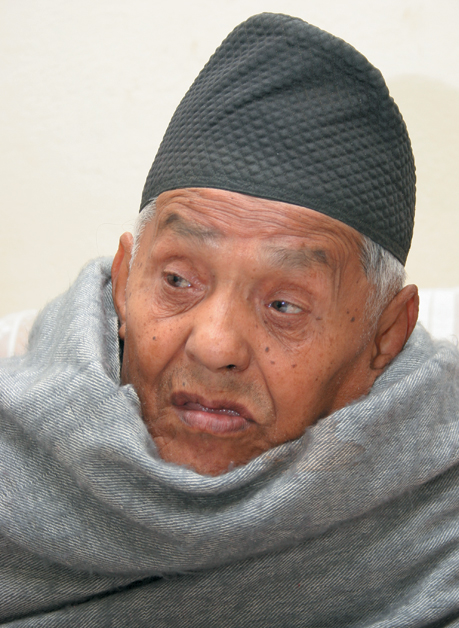Born in 1926, Hem Raj Shakya is the most prominent and knowledgeable scholar on Buddhism, which is practiced in the Kathmandu valley. He is a specialist in epigraphy, a unique science that specializes in reading and translating to make sense of short writings on pillars, statues and stone tablets. Not only are the writings in Sanskrit, (Newari) Ranjana or Gupta scripts, but they could also contain a combination of two or more languages. Moreover, different rulers at different times used various methods that made it harder for people to decipher the era. Furthermore, words do not have the same meaning at different times but to make sense of it all, Hem Raj Shakya even today at this age relentlessly assists those who seek his expertise. He was able to learn and master this unique skill and insight into the world of ancient scripts under the guidance of his mentor, Dharmaditya Dharamacharya and Todacananda, who he acknowledges with revered gravity.
 In the course of his amazing lifetime, Hem Raj has been honored with countless recognition here and abroad for his remarkable work. Recipient of the Gorkha Dakshin Bahu in 1910, he was also recognized with the ‘Shrestha Sirapa’ for Nepal Sanskritiya Mulukha – 1969 and Swayambhu Mahachaitya – 1981. He was also awarded two gold medals for his publications: Mayurvarna Mahaviharya Sanskipta Itihas – 1973 and Manigal Raj Prasad – 1974. He is the holder of Mahendra Pragya Puraskara, 1986; Ganesha Man Singh Pratisthan Puraskar, 1998 and was honored as Bhasha Thuwab by Nepal Bhasha Parishad, 1990.
In the course of his amazing lifetime, Hem Raj has been honored with countless recognition here and abroad for his remarkable work. Recipient of the Gorkha Dakshin Bahu in 1910, he was also recognized with the ‘Shrestha Sirapa’ for Nepal Sanskritiya Mulukha – 1969 and Swayambhu Mahachaitya – 1981. He was also awarded two gold medals for his publications: Mayurvarna Mahaviharya Sanskipta Itihas – 1973 and Manigal Raj Prasad – 1974. He is the holder of Mahendra Pragya Puraskara, 1986; Ganesha Man Singh Pratisthan Puraskar, 1998 and was honored as Bhasha Thuwab by Nepal Bhasha Parishad, 1990.
Shakya has established Hemraj Sirapa and Hemraj Hahpab prizes in 1991 for the aspiring younger generation who want to follow in his footsteps and continue the work he has so ably maintained. Frail in health, conversations for prolonged periods is difficult, but he overcomes his discomfiture with a humble smile. The following are extracts from our short encounter.
Your first and last assignment as an epigraphy expert was?
I was first assigned as Pandit at Bir Library in 1951, after the end of Rana rule in Nepal. Five years later, I became an epigraphy specialist at the then Department of Archeology and Culture. I served in the government office as Script Expert in the Department of Archeology from 1956 till 1983. I continued working in this position for 32 years. After retirement, for 12 years I worked on the translation of ancient books at the Nepal German Research Center.
How did your book Sri Swayambhu Mahachaity materialize?
It was the result of my 22 year long daily ritual walk to Swayambhu from Patan some 55 years ago. It took me 22 years to research the book and in doing so, I have also meticulously captured the history of Nepal.
Authors note: Sri Swayambhu Mahachaity is the largest volume ever researched and written on Swayambhu. It is the most comprehensive book on just about every aspect of not just this famous world heritage site but in effect the history of Kathmandu valley. This great work by Hem Raj also contains a complete inventory of every stone inscription from the Lichavi, Malla and Shah period found on the hill. Unlike other writers, Shakya explains the sources and locations of the inscriptions from which he has put this masterpiece together. It was originally published in Newari and was recently translated into English by Min Bahadur Shakya. It is available in major book stores in Kathmandu.
Tell us about the Mahaboudha temple in Patan?
My family tree and history explains that Abhaya Raj Shakya, one of my forefathers was inspired by the temple he saw on his pilgrimage to Bodh Gaya. It took a lot of resources and three generations of the family to actually see it completed. It now is a landmark of Patan and also is known as the “temple of the thousand Buddhas”.
Do you have any attached ment to a particular publication of yours?
Of the 73 publications, Karunamaya stands out in the crowd and I am emotional about the research into the legends, history and the annual chariot festival of the Rato Machhindranath. Three times in my lifetime the chariot of the ultimate symbol of compassion for the people of the valley broke down in front of my house and the idols and chariot had to be dismantled and rebuilt for a period of over 3 months. I took it as a calling and spent the entire time researching and then published the book.










